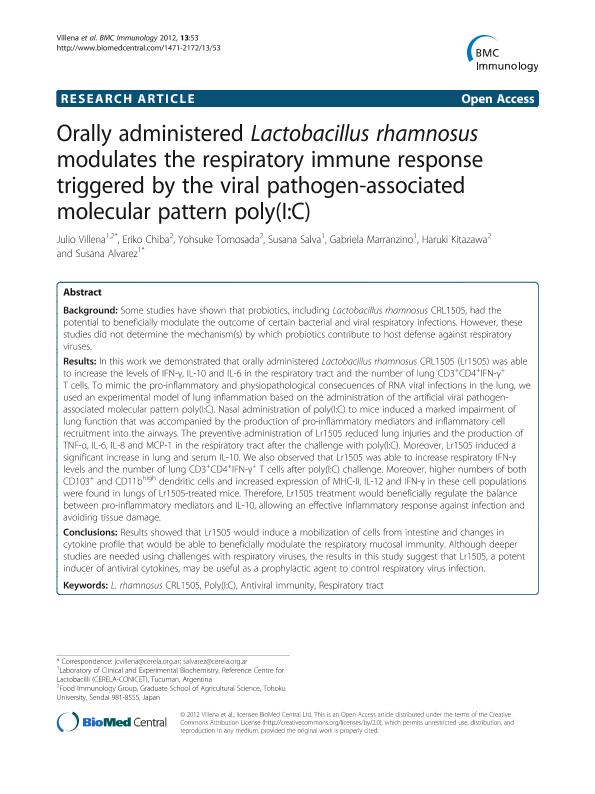Mostrar el registro sencillo del ítem
dc.contributor.author
Villena, Julio Cesar

dc.contributor.author
Chiba, Eriko
dc.contributor.author
Tomosada, Yohsuke
dc.contributor.author
Salva, Maria Susana

dc.contributor.author
Marranzino, Gabriela

dc.contributor.author
Kitazawa, Haruki
dc.contributor.author
Alvarez, Gladis Susana

dc.date.available
2017-05-15T17:28:16Z
dc.date.issued
2012-09
dc.identifier.citation
Villena, Julio Cesar; Chiba, Eriko; Tomosada, Yohsuke; Salva, Maria Susana; Marranzino, Gabriela; et al.; Orally administered Lactobacillus rhamnosus modulates the respiratory immune response triggered by the viral pathogen-associated molecular pattern poly(I:C); Biomed Central; BMC Immunology; 13; 53; 9-2012; 1-15
dc.identifier.issn
1471-2172
dc.identifier.uri
http://www.biomedcentral.com/1471-2172/13/53
dc.identifier.uri
http://hdl.handle.net/11336/16480
dc.description.abstract
Some studies have shown that probiotics, including Lactobacillus rhamnosus CRL1505, had the potential to beneficially modulate the outcome of certain bacterial and viral respiratory infections. However, these studies did not determine the mechanism(s) by which probiotics contribute to host defense against respiratory viruses. In this work we demonstrated that orally administered Lactobacillus rhamnosus CRL1505 (Lr1505) was able to increase the levels of IFN-γ, IL-10 and IL-6 in the respiratory tract and the number of lung CD3(+)CD4(+)IFN-γ(+) T cells. To mimic the pro-inflammatory and physiopathological consecuences of RNA viral infections in the lung, we used an experimental model of lung inflammation based on the administration of the artificial viral pathogen-associated molecular pattern poly(I:C). Nasal administration of poly(I:C) to mice induced a marked impairment of lung function that was accompanied by the production of pro-inflammatory mediators and inflammatory cell recruitment into the airways. The preventive administration of Lr1505 reduced lung injuries and the production of TNF-α, IL-6, IL-8 and MCP-1 in the respiratory tract after the challenge with poly(I:C). Moreover, Lr1505 induced a significant increase in lung and serum IL-10. We also observed that Lr1505 was able to increase respiratory IFN-γ levels and the number of lung CD3(+)CD4(+)IFN-γ(+) T cells after poly(I:C) challenge. Moreover, higher numbers of both CD103(+) and CD11b(high) dendritic cells and increased expression of MHC-II, IL-12 and IFN-γ in these cell populations were found in lungs of Lr1505-treated mice. Therefore, Lr1505 treatment would beneficially regulate the balance between pro-inflammatory mediators and IL-10, allowing an effective inflammatory response against infection and avoiding tissue damage. Results showed that Lr1505 would induce a mobilization of cells from intestine and changes in cytokine profile that would be able to beneficially modulate the respiratory mucosal immunity. Although deeper studies are needed using challenges with respiratory viruses, the results in this study suggest that Lr1505, a potent inducer of antiviral cytokines, may be useful as a prophylactic agent to control respiratory virus infection.
dc.format
application/pdf
dc.language.iso
eng
dc.publisher
Biomed Central

dc.rights
info:eu-repo/semantics/openAccess
dc.rights.uri
https://creativecommons.org/licenses/by/2.5/ar/
dc.subject
L. Rhamnosus Crl1505
dc.subject
Poli(I:C)
dc.subject
Antiviral Immunity
dc.subject
Respiratory Tract
dc.subject.classification
Sistema Respiratorio

dc.subject.classification
Medicina Clínica

dc.subject.classification
CIENCIAS MÉDICAS Y DE LA SALUD

dc.title
Orally administered Lactobacillus rhamnosus modulates the respiratory immune response triggered by the viral pathogen-associated molecular pattern poly(I:C)
dc.type
info:eu-repo/semantics/article
dc.type
info:ar-repo/semantics/artículo
dc.type
info:eu-repo/semantics/publishedVersion
dc.date.updated
2016-11-18T15:12:19Z
dc.identifier.eissn
1471-2172
dc.journal.volume
13
dc.journal.number
53
dc.journal.pagination
1-15
dc.journal.pais
Reino Unido

dc.journal.ciudad
Londres
dc.description.fil
Fil: Villena, Julio Cesar. Consejo Nacional de Investigaciones Científicas y Técnicas. Centro Científico Tecnológico Conicet - Tucuman. Centro de Referencia Para Lactobacilos; Argentina. Tohoku University. Graduate School of Agricultural Science. Food Immunology Group; Japón
dc.description.fil
Fil: Chiba, Eriko. Tohoku University. Graduate School of Agricultural Science. Food Immunology Group; Japón
dc.description.fil
Fil: Tomosada, Yohsuke. Tohoku University. Graduate School of Agricultural Science. Food Immunology Group; Japón
dc.description.fil
Fil: Salva, Maria Susana. Consejo Nacional de Investigaciones Científicas y Técnicas. Centro Científico Tecnológico Conicet - Tucuman. Centro de Referencia Para Lactobacilos; Argentina
dc.description.fil
Fil: Marranzino, Gabriela. Consejo Nacional de Investigaciones Científicas y Técnicas. Centro Científico Tecnológico Conicet - Tucuman. Centro de Referencia Para Lactobacilos; Argentina
dc.description.fil
Fil: Kitazawa, Haruki. Tohoku University. Graduate School of Agricultural Science. Food Immunology Group; Japón
dc.description.fil
Fil: Alvarez, Gladis Susana. Consejo Nacional de Investigaciones Científicas y Técnicas. Centro Científico Tecnológico Conicet - Tucuman. Centro de Referencia Para Lactobacilos; Argentina
dc.journal.title
BMC Immunology

dc.relation.alternativeid
info:eu-repo/semantics/altIdentifier/url/https://bmcimmunol.biomedcentral.com/articles/10.1186/1471-2172-13-53
dc.relation.alternativeid
info:eu-repo/semantics/altIdentifier/doi/http://dx.doi.org/10.1186/1471-2172-13-53
Archivos asociados
